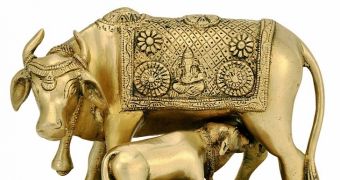A six-year-old Indian boy is being worshipped like a God by people in his small village because of a 12-inch (30.48-cm) tail growing on his back.
Amar Singh, from Nijmapur, a small village in the state of Uttar Pradesh in northern India, was born with a patch of thick hair starting in the small of his back, which has grown so long that it now resembles a tail.
Locals believe his physical peculiarity is a religious sign and that the boy is somehow connected to the Hindu god Hanuman, a monkey-like deity. Although it may seem kind of weird, his family also compared him to a cow, which is a holy animal in Hindu culture.
They have also come up with a theory saying that Amar's interest in cows also proves that he has godly connections, Daily Mail reports.
Apparently, the weird patch of hair was originally about one inch (2.54 cm) long, but grew over the years and now he can even plait it.
Although people in his village consider him as a god-like figure, his father Ajmer Singh describes Amar as a normal boy. He says that despite his anomaly, his son is a “healthy and normal boy who does well at his studies.”
“Amar is a very loving child. Everybody sees him as a symbol of god,” Mr. Singh adds.
Obviously, Amar's extra hair could easily be cut or shaved off, but his family refuses to do this because they consider the “tail” to be a gift from God.
However, there is a medical explanation of the boy's unusual patch of hair, and it has nothing to do with religion and gods. As it turns out, the strip of hair is actually a result of a birth defect called spina bifida.
The congenital disorder occurs when something goes wrong during the first month of an embryo's development, causing the incomplete closing of the spinal column. Spina bifida can be surgically closed after birth, but this does not restore normal function to the affected part of the spinal cord.
Spina bifida occulta is the mildest form of the defect, and means that the outer part of some of the vertebrae is not completely closed. The opening that it forms there is usually covered with skin, which can be normal skin or may have some hair growing from it, exactly like in Amar's case.
According to medical records, the incidence of spina bifida occulta is approximately 10-20% of the population.

 14 DAY TRIAL //
14 DAY TRIAL //